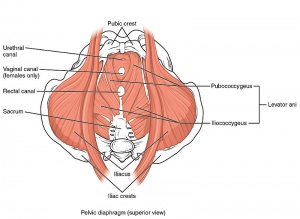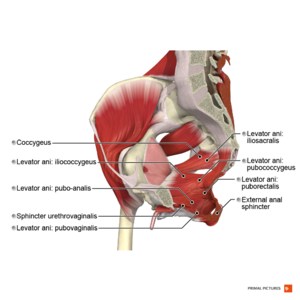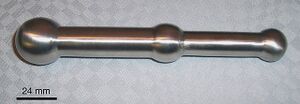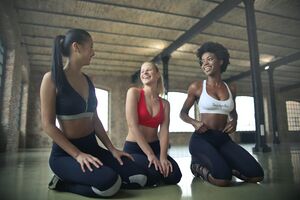Kegel's Exercise: Females
Editor: Bianca Cristiana Rus
This article or area is currently under construction and may only be partially complete. Please come back soon to see the finished work! (25/04/2023)
Definition[edit | edit source]
Kegel exercise is also known as pelvic-floor exercise .It involves frequently contracting and relaxing the muscles that form part of the pelvic floor.
The aim of these exercises is to strengthen the pelvic floor muscles which have many functions in our body.
The first published description of these exercises was made by The American gynecologist Arnold Kegel in 1948. The perineometer ( the vaginal manometer) has been designed to record the contraction strength of pelvic floor muscles. It can be used to guide the participants to conduct the exercises correctly. Dr. Kegel’s study showed that the exercises could help in prevention of:
- cystocele, rectocele, and urinary stress incontinence
Function[edit | edit source]
In female`s body , they are responsible for:
- holding up the bladder
- preventing urinary stress incontinence (especially after childbirth)
- vaginal and uterine prolapse. [1]
Mechanism of Action[edit | edit source]
The main goal of Kegel exercises is to improve muscle tone by strengthening the pubococcygeus muscles of the pelvic floor. It may also help to increase sexual gratification, can help women to complete pompoir and aiding men in reducing premature ejaculation.
The pelvic-floor exercises involve the entire levator ani, contracts, and relax as on muscle.
The supportive systems composed by :the pelvic floor muscles, the vaginal wall, the arcus tendinous fascia pelvis, endopelvic fascia. The pelvic floor muscles (PFM), which consist of the levator ani and coccygeus muscles, are crucial for supporting pelvic organs. The levator ani muscle comprises three portions: the puborectalis, pubococcygeus, and iliococcygeus muscles. The puborectalis muscle forms a sling around the anorectal junction. By contracting the puborectalis muscle, the urogenital hiatus closes during physical activities. The pubococcygeus muscle runs from the pubis to the coccyx, and the iliococcygeus muscle is the most lateral part of the levator ani muscle. They form a flat plate called the levator plate, helping stabilize the pelvic organ. However, the pelvic floor muscles may become weakened by aging, pregnancy, vaginal delivery, surgery, etc. As a result, the patient will suffer from urinary incontinence and pelvic organ prolapses.
Understand the importance of Kegel exercises[edit | edit source]
There are many factors that can lead to weak pelvic floor muscles: pregnancy, childbirth, surgery, aging, being overweight, excessive straining from constipation, or chronic coughing.
Kegel exercises may help you if you have problems like :
- Leak a few drops of urine while sneezing, laughing, or coughing (stress incontinence)
- Have a strong, sudden urge to urinate just before losing a large amount of urine (urinary urge incontinence)
- Leak stool (fecal incontinence)
These exercises can also be done during all periods of pregnancy or after childbirth. [2]
Try to make these like a daily routine. You can expect results after a few weeks but it can also take a few months, depending from person to person.
Pelvic floor exercises strengthen the muscles around your bladder, bottom, and vagina or penis.
The importance of strengthening pelvic floor muscles is that it will help in conditions like urinary incontinence, pelvic organ prolapse .It will make sex better too.
People should continue doing the exercises even when they start to notice results .
Pregnant women or the ones who are planning to get pregnant, they should start doing pelvic floor exercises immediately as it will lower the chances of experiencing incontinence after having the baby.
How to do Kegel exercises[edit | edit source]
Step 1- Try to identify Kegel muscles-pelvic floor muscles. You can feel your pelvic floor muscles when are n the toilet and you try to stop the flow of urine.[NHS website]
It's not recommended to regularly stop the flow of urine midstream. This can be harmful to the bladder.
Step 2- You can do it in any position that works for you even when staying at your desk but most of people prefer to do it lying down. Work on your technique every day. Try to imagine that you are sitting on a marble. Try tightening your pelvic muscles as if lifting the marble and holding it for three seconds. After that start relaxing for another three.
Step 3- Make sure you always maintain your focus when tightening your pelvic floor muscles. Do not flex the muscles in your abdomen, thighs, buttocks and please do not forget to breathe freely during the exercises.
Step 4- Do at least three sets of 10 to 15 repetitions a day.
Step 5 - Try to include these exercises in your daily routine.
Devices used to increase tone in pelvic muscles[edit | edit source]
- A Kegel exerciser
- Jade eggs- used in vaginal weightlifting
- Ben Wa balls
It seems that there was no evidence that doing pelvic floor exercises with weights worked better than doing Kegel exercises without weights. The use of these devices comes with greater risk because a foreign object is introduced into the vagina :the risk of infection and can lead to vaginosis or toxic shock syndrome.
Resources[edit | edit source]
[1] 2. NHS ARTICLE-what are pelvic floor exercises? last reviewed 14 April 202
3.KEGEL AH. Progressive resistance exercise in the functional restoration of the perineal muscles. Am J Obstet Gynecol. 1948 Aug;56(2):238-48. - PubMed
- Ashton-Miller JA, DeLancey JO. Functional anatomy of the female pelvic floor. Ann N Y Acad Sci. 2007 Apr;1101:266-96. - PubMed
- Zanetti MR, Castro Rde A, Rotta AL, Santos PD, Sartori M, Girão MJ. Impact of supervised physiotherapeutic pelvic floor exercises for treating female stress urinary incontinence. Sao Paulo Med J. 2007 Sep 06;125(5):265-9. - PubMed
This article or area is currently under construction and may only be partially complete. Please come back soon to see the finished work! (25/04/2023)
This article or area is currently under construction and may only be partially complete. Please come back soon to see the finished work! (25/04/2023)
- ↑ reference










